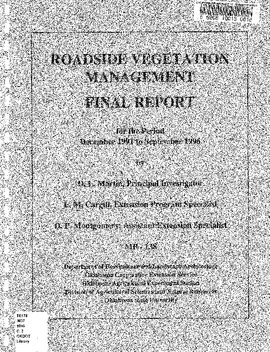| dc.creator | Martin, D.L. | |
| dc.creator | Cargill, L.M. | |
| dc.creator | Montgomery, D.P. | |
| dc.date.accessioned | 2018-08-06T14:59:04Z | |
| dc.date.available | 2018-08-06T14:59:04Z | |
| dc.date.issued | 1996-9 | |
| dc.identifier.govdoc | FHWA-ODOT-95-05 | |
| dc.identifier.other | Oklahoma Department of Transportation State Planning and Research item number 2404 | |
| dc.identifier.uri | https://hdl.handle.net/11244/301362 | |
| dc.description.abstract | The infonnation contained within this report addresses: (1) Research - involving the use of experimental, newly labeled and traditionally available herbicides in combination with mowing for roadside vegetation management; (2) Maintenance implementation of research results into an operational phase of the Oklahoma Department of Transportation ·s (ODOT) maintenance program. as well as performing on-site visits, telephone and written consultation to ODOT personnel; and (3) Training - conducting pesticide applicator certification programs, and providing continuing education programs for these certified applicators. The following are conclusions based on our research: (1) Campaign herbicide or Roundup plus 2,4-D may be used postemergence in place of atrazine or diuron applied pre-emergence for the control of winter annual grasses and broadleaf weeds. Tlllling of herbicide application is critical. (2) Ammonium sulfate may be added to either Campaign herbicide or the combination treatment of Roundup + 2,4-D amine to i?lprove control of winter annual weeds. This product addition may allow end users to reduce use rates of these herbicides. (3) Primo plus Oust may be used for temporary growth and seedhead suppression of common bermudagrass on roadsides; additional product labeling will be required to implement this treatment into the maintenance phase of ODOTs vegetation management'program. (4) The product Plateau., when combined with Roundup, will provide an acceptable level of both seedling and rhizome johnsongrass control (minimum of 80% control) in common bermudagrass roadsides with potential to reduce phytotoxicity as compared to the traditional Oust plus Roundup herbicide treatment. Several research plot tours, meetings, sprayer calibration workshops, musk thistle head weevil collection/release days as well as herbicide/fertilizer demonstrations were conducted throughout the duration of this project in order to implement current research information into an operational phase of ODOTs roadside vegetation management program. Training achievements included the execution of 12 pesticide applicator certification schools resulting in 146 new herbicide applicators becoming certified. A total of 68 continuing education programs were conducted with 2, 795 ODOT certified applicators attending over a 5 year period. Numerous training information sheets were developed and provided to applicators during workshops. | |
| dc.format.extent | 221 pages | |
| dc.format.extent | 47,963,034 bytes | |
| dc.format.medium | application.pdf | |
| dc.language | en_US | |
| dc.relation.ispartofseries | No | |
| dc.relation.requires | Adobe Acrobat Reader | |
| dc.title | Roadside vegetation management final report for the period December 1991 to September 1996 (FHWA-ODOT-96-05) 2187 | |
| dc.type | Technical Report | |
| dc.description.version | Final Report, December 1991-September 1996 | |
| dc.description.peerreview | No | |
| dc.type.material | text | |
| dc.subject.keywords | Bermudagrass | |
| dc.subject.keywords | Johnsongrass | |
| dc.subject.keywords | Switchgrass | |
| dc.subject.keywords | Musk thistle | |
| dc.subject.keywords | Kochia | |
| dc.subject.keywords | Spray drift control | |
| dc.subject.keywords | Weed control | |
| dc.subject.keywords | Brush control | |
| dc.subject.keywords | Spray adjuvants | |
| dc.contributor.sponsor | Oklahoma Department of Transportation. Materials and Research Division. Office of Research & Implementation | |
